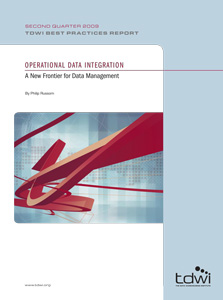
TDWI Best Practices Report | Operational Data Integration: A New Frontier for Data Management
April 1, 2009
The amount and diversity of work done by data integration specialists has exploded since the turn of the twenty-first century. A lot of the growth comes from the emerging practice of operational data integration, which is usually applied to the migration, consolidation, or synchronization of operational databases, plus business-to-business data exchange.
But growth comes at a cost. Many corporations have staffed operational data integration by borrowing data integration specialists from data warehouse teams, which puts important BI work in peril. Others have gone to the other extreme by building new teams and infrastructure that are redundant with analytic efforts. In many firms, operational data integration’s contributions to the business are limited by legacy, hand-coded solutions that are in dire need of upgrade or replacement. And the best practices of operational data integration on an enterprise scale are still coalescing, so confusion abounds.
This report identifies best practices and common pitfalls involved in starting and sustaining a program for operational data integration. Along the way, we’ll look at staffing and other organizational issues, as well as technical requirements and vendor products that apply to operational data integration projects.
Content Provided by
TDWI, IBM, DataFlux, Expressor Software, GoldenGate Software, Informatica, SAP, Silver Creek Systems, Sybase, Talend